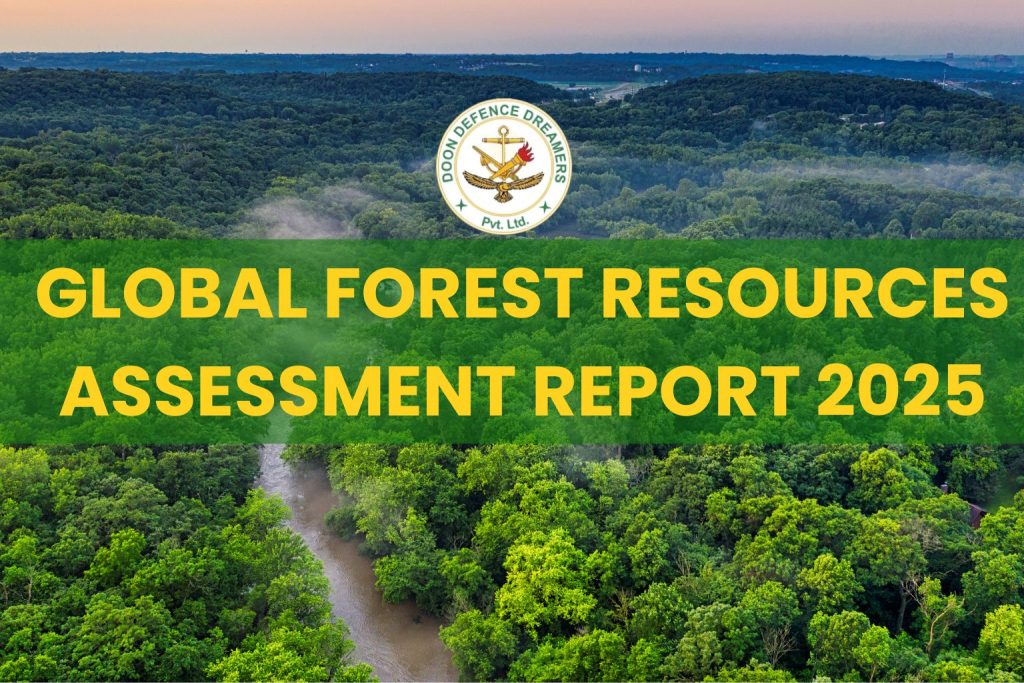India’s Achievement – Let’s Start from Here
According to the latest Global Forest Resources Assessment Report 2025 (Global Forest Resources Assessment – GFRA 2025), India has achieved a major environmental milestone. In this report released by the UN agency FAO:
India has reached 9th position in the world in terms of total forest area (earlier it was in 10th place).
India continues to hold the 3rd position in net annual forest area gain.
India ranks 5th among the world’s top carbon-sink countries; our forests are absorbing nearly 150 million tonnes of CO₂ every year between 2021–2025.
At the global level, total forest area is about 4.14 billion hectares, out of which India alone holds around 72.7 million hectares (72,739 thousand hectares) – roughly 2% of the world’s forests.
With such a strong position, when we read the Global Forest Resources Assessment Report 2025, it is no longer just a set of numbers – it becomes the story of India’s green future.
What Is the Global Forest Resources Assessment Report 2025?
The Global Forest Resources Assessment Report 2025 is a global report published by FAO every five years. It collects official data from almost all countries and looks at:
How much total forest area exists in the world
Where forests are declining and where they are increasing
The proportion of naturally regenerating and planted forests
The status of forest management, timber extraction, biodiversity and carbon stocks
In other words, the Global Forest Resources Assessment Report 2025 tells us what condition the world’s forests are in and how far they are helping to achieve climate goals, biodiversity conservation and sustainable development targets.
The Global Picture: Where Do the World’s Forests Stand?
According to the report: (Global Forest Resources Assessment Report 2025)
The world’s total forest area is about 4.14 billion hectares – nearly 32% of the Earth’s land surface.
54% of global forests are concentrated in just five countries – Russia, Brazil, Canada, the United States and China.
Europe holds around 25% of the world’s forest area, while in South America nearly 49% of the land is under forests.
The report also shows that in the 1990–2000 decade, about 10.7 million hectares of forest were being lost every year. Between 2015–2025, this net loss has fallen to about 4.12 million hectares a year – which means the speed of loss has reduced, although the threat is still very real.
In this global context, the Global Forest Resources Assessment Report 2025 makes it clear that Asia—especially India and China—is the region where net gain in forest area is being recorded.
India’s Status: The Story Told by the Numbers
Now let us see what the Global Forest Resources Assessment Report 2025 says about India.
Total Forest Area and Share in the World
India’s total forest area is about 72.7 million hectares.
This is roughly 2% of the global forest area.
Ranking
In terms of total forest area, India ranks 9th in the world (earlier 10th).
India continues to hold 3rd place in net annual forest area gain – which means that in terms of the new forest added every year, only two countries are ahead of India.
India as a Carbon Sink
FAO has placed India 5th among the top global carbon-sink countries. Our forests are absorbing nearly 150 Mt CO₂ every year between 2021–2025.
Forest Cover Within the Country
According to India’s own ISFR 2023, the country’s total forest cover is 7,15,343 sq km, which is 21.76% of the country’s geographical area.
The states with the largest forest areas are Madhya Pradesh, Arunachal Pradesh and Chhattisgarh.
Mangrove cover is about 4,992 sq km, which is extremely important for coastal protection and biodiversity.
These figures clearly show that the Global Forest Resources Assessment Report 2025 does not see India only as a “green country”, but recognises it as an active green leader.
Why Are India’s Achievements in the 2025 Report So Special?
Growing Forest Area, Narrowing Rank Gap
Earlier India stood at 10th place; now it is 9th. It may sound like a small step, but remember that the top ranks are held by huge land-mass countries such as Russia, Brazil, Canada, the US and China. For a country with high population density, India’s 9th position is a significant achievement.
Net Annual Forest Gain – 3rd Place
Between 2015–2025, India has recorded an average net forest gain of about 0.191 million hectares per year, placing it 3rd in the world.
This means that despite felling and degradation, the efforts of tree plantation and restoration of old forests are leading to an overall increase in forest area.
Fighting Climate Change
When India’s forests absorb around 150 Mt CO₂ every year, it is a relief not only for us but for the whole world. This carbon sink plays a major role in meeting India’s Nationally Determined Contribution (NDC) targets under climate agreements.
A Positive Picture for Asia
Asia is the only region where net increase in forest area has been recorded since 1990, and India’s contribution to this trend is highly significant.
How Has This Progress Happened? – India’s Policies and Programmes
Behind the success reflected in the Global Forest Resources Assessment Report 2025, there are several long-running policies and programmes in India:
Green India Mission (GIM)
Launched in 2014 under the National Action Plan on Climate Change.
Objective: to increase forest and tree cover by 5 million hectares and improve the quality of forests on another 5 million hectares of degraded land.
National Afforestation Programme and CAMPA
Focus on reforestation of degraded and barren lands.
Wherever forest land is diverted for development projects, compensatory afforestation is taken up on an equivalent or larger area elsewhere.
Joint Forest Management and Community Participation
Village communities and the Forest Department work together through Global forest protection committees.
In return, local people receive benefits from minor forest produce, fodder and in some cases timber revenues, so they see forest conservation as part of their own interest.
Van Dhan Yojana and NTFP-Based Livelihoods
In tribal regions, value addition to forest products (like mahua, tendu leaves, sal seeds, bamboo, etc.) helps increase local income.
This encourages people to protect trees and use them in a sustainable way rather than cutting them down.
Mission LiFE and “Ek Ped Ma Ke Naam”
Campaigns that promote environment-friendly lifestyles.
Initiatives such as “Ek Ped Ma Ke Naam” connect people emotionally to tree planting and protection.
Together, these efforts have built the foundation that the Global Forest Resources Assessment Report 2025 now showcases to the world as a success model.
What Are the Remaining Challenges?
Higher ranking alone is not enough. In the context of the Global Forest Resources Assessment Report 2025, India must pay special attention to some key challenges:
Forest Quality vs. Mere Numbers
In many areas, natural forests are being replaced by single-species plantations, which reduces biodiversity.
Compared to dense natural forests, such plantations are less beneficial for both climate stability and wildlife.
Forest Fires and Climate Change
In 2024, the world saw forest fires at record levels, and with rising temperatures this risk may increase for India as well.
In dry regions—especially parts of central India and the Western Ghats—it is essential to strengthen fire management and early-warning systems.
Development vs. Conservation
Roads, railways, mining and infrastructure projects often expand at the cost of forest land.
Every development decision needs to balance growth with conservation, keeping in mind the findings of reports like the Global Forest Resources Assessment Report 2025.
Human–Wildlife Conflict
Fragmentation of forests forces animals such as elephants, tigers and leopards to move closer to villages, increasing conflict.
We must find sustainable solutions that protect both people and wildlife.
Key Points for Exams (Global Forest Resources Assessment Report 2025)
For students, some direct facts from the Global Forest Resources Assessment Report 2025 are easy to remember:
Who publishes the report? – FAO (Food and Agriculture Organization).
How often? – Every 5 years.
According to GFRA 2025, India’s status is:
9th place in the world in total forest area (earlier 10th).
3rd place in net annual forest area gain.
5th place among global carbon-sink countries.
India’s total forest area – about 72.7 million hectares, around 2% of global forest area.
World’s total forest area – about 4.14 billion hectares (around 32% of land surface).
These points can be asked directly in exams like UPSC, PCS, SSC, Forest Services and other environment-related papers.
What Does This Mean for Ordinary Citizens?
You might ask, “It’s good that India’s rank has improved, but what does it mean for my daily life?”
When India’s rank rises, our environmental credibility in the world becomes stronger, and our voice in climate negotiations gains more weight.
When forests grow, the air around your town or village becomes cleaner, temperatures are moderated, and rivers and streams become more stable.
Increase in forest area can also strengthen the livelihoods of tribal and forest-dependent communities—provided that schemes are implemented properly.
If you are a student, teacher or ordinary citizen, this is an inspiration to plant trees, reduce plastic use and demand better environmental decisions from policymakers.
When we treat nature as a friend and walk with it, India’s position in reports like the Global Forest Resources Assessment Report 2025 will keep improving.
Conclusion
The Global Forest Resources Assessment Report 2025 gives us an important message: the world’s forests are still under pressure, but with the right policies and collective effort, the picture can change.
India’s 9th place in total forest area, 3rd place in net forest gain and 5th place as a carbon sink prove that rapid development and environmental protection can move forward together.
Now the need is:
Not to be satisfied only with numbers, but to take forest quality, biodiversity and the rights of local communities just as seriously.
To ensure that from schools to Parliament, serious discussions take place on how India can further expand its forest area and carbon-sink capacity in the next 10–20 years.
If government, scientists, local communities and ordinary citizens work together, then in future assessments this success shown in the Global Forest Resources Assessment Report 2025 will be seen not as the final goal, but as just the starting point of India’s green journey.
About Doon Defence Dreamers
Doon Defence Dreamers, based in Dehradun, is a focused defence coaching academy that trains aspirants for NDA, CDS, AFCAT, RIMC, RMS and SSB interviews through experienced faculty and individual guidance. Students benefit from hostel accommodation, regular ground training, dedicated doubt-solving sessions and a well-structured daily routine that keeps their preparation disciplined and consistent. With more than 710 NDA written qualifiers and a strong record of SSB recommendations, our results speak for the strength of our teaching and mentoring system. For serious defence aspirants, Doon Defence Dreamers is widely regarded as the Best NDA Coaching in Dehradun and a reliable launchpad for a career as an officer in the Indian Armed Forces.






























